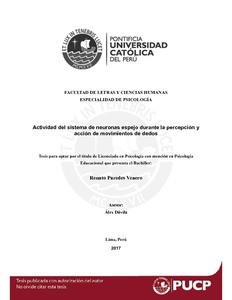| dc.contributor.advisor | Dávila, Alex | es_ES |
| dc.contributor.author | Paredes Venero, Renato | es_ES |
| dc.date.accessioned | 2017-03-13T15:22:08Z | es_ES |
| dc.date.available | 2017-03-13T15:22:08Z | es_ES |
| dc.date.created | 2017 | es_ES |
| dc.date.issued | 2017-03-13 | es_ES |
| dc.identifier.uri | http://hdl.handle.net/20.500.12404/8170 | |
| dc.description.abstract | Resumen:
La comprensión de los mecanismos neuronales involucrados en la percepción y acción de
movimientos puede contribuir a la formación de músicos y cirujanos. En ese marco, la presente
investigación tuvo como objetivo determinar la actividad del sistema de neuronas espejo durante
la observación y ejecución de movimientos de dedos. Para ello, se registró la actividad cerebral
de seis participantes (tres hombres y tres mujeres) con edades entre 21 y 26 años con un equipo
BIOPAC durante tres condiciones experimentales: observación, ejecución y control. La tarea
consistió en observar o ejecutar el movimiento de tocar las puntas de los dedos con la punta del
dedo pulgar secuencialmente a una frecuencia de 2Hz. Por otra parte, la condición de control
consistió en observar una almohada en posición estática. Después de descartar artefactos, se
calculó la desincronización relacionada a eventos (DRE) en cada condición experimental y en
cuatro bandas de frecuencia. Pruebas de Wilcoxon mostraron que la condición ejecución (Mdn =
-41.70) tuvo valores de DRE más pronunciados que la condición de control (Mdn = -8.6) (Z = -
3.58) (r=-.73). Asimismo, indicaron que no hubo diferencias entre la condición de observación
(Mdn = -30.95) y las condiciones de ejecución (Z = 2.04) (r=.42) y control (Z = -2.22) (r=-.45).
Los resultados aportan evidencia favorable pero no concluyente respecto al rol del sistema de
neuronas espejo en la vinculación de la percepción y acción de movimientos de dedos. Mejoras
metodológicas son necesarias para generalizar los hallazgos y evaluar sus potenciales
aplicaciones en la educación. | es_ES |
| dc.description.abstract | Abstract:
Understanding the neural mechanisms involved in perception and action of movements can
contribute to the training of musicians and surgeons. In this context, the present study was aimed
to determine the activity of the mirror neuron system during observation and execution of
sequential finger movements. To do this, the brain activity of six participants (three males and
three females) was recorded with a BIOPAC MP100 in three experimental conditions:
observation, execution and control. The experimental task was to observe or execute the
movement of touching the fingertips with the tip of the thumb sequentially at a frequency of 2
Hz. Similarly, the control condition was to observe a pillow in a static position. After discarding
artifacts, the event-related desynchronization (ERD) was computed in each of the three
experimental conditions and in four frequency bands. Wilcoxon tests showed that the execution
condition ERD values (Mdn = -41.70) were more pronounced than the control condition ones
(Mdn = -8.6) (Z = -3.58) (r=-.73). They also indicated that the observation condition did not have
different ERD values than the execution (Z = 2.04) (r=.42) and the control conditions (Z = -2.22)
(r=-.45). These results provide supportive but not conclusive evidence regarding the role of the
human mirror neuron system in linking perception and action of finger movements.
Methodological improvements are required to generalize these findings and assess their potential
applications in education. | es_ES |
| dc.language.iso | spa | es_ES |
| dc.publisher | Pontificia Universidad Católica del Perú | es_ES |
| dc.rights | Atribución-NoComercial-SinDerivadas 2.5 Perú | * |
| dc.rights | info:eu-repo/semantics/openAccess | es_ES |
| dc.rights.uri | http://creativecommons.org/licenses/by-nc-nd/2.5/pe/ | * |
| dc.subject | Neuropsicología | es_ES |
| dc.subject | Aptitud motora. | es_ES |
| dc.subject | Dedos -- Movimiento. | es_ES |
| dc.title | Actividad del sistema de neuronas espejo durante la percepción y acción de movimientos de dedos | es_ES |
| dc.type | info:eu-repo/semantics/bachelorThesis | es_ES |
| thesis.degree.name | Licenciado en Psicología Educacional | es_ES |
| thesis.degree.level | Título Profesional | es_ES |
| thesis.degree.grantor | Pontificia Universidad Católica del Perú. Facultad de Letras y Ciencias Humanas | es_ES |
| thesis.degree.discipline | Psicología Educacional | es_ES |
| renati.discipline | 313046 | es_ES |
| renati.level | https://purl.org/pe-repo/renati/level#tituloProfesional | es_ES |
| renati.type | http://purl.org/pe-repo/renati/type#tesis | es_ES |
| dc.publisher.country | PE | es_ES |
| dc.subject.ocde | http://purl.org/pe-repo/ocde/ford#5.01.00 | es_ES |






